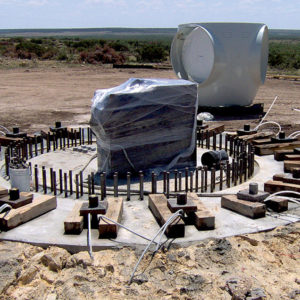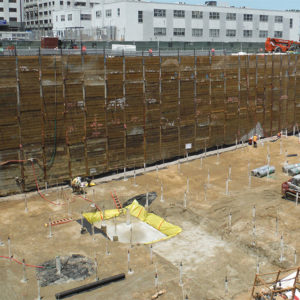Tieback & Tiedown Anchors
Williams Grade 150 KSI All-Thread Bars, Grade 75 & Grade 80 All-Thread Bars, Geo-Drill Injection Anchors and 270 KSI low relaxation strand have been successfully used as Prestressed Ground Anchors for a wide variety of Civil Engineering applications. Bonded deep into the ground using cementitious grout, these anchors transfer necessary forces to resists walls from overturning, water tanks from uplift, towers from uplift, dams from rotating and other naturally or phenomenally occurring forces applied to structures. Anchors are designed and fabricated to the latest standards as set forth in the Post-Tensioning Institute’s Recommendations for Prestressd Rock and Soil Anchors. Anchor capacity is a function of the steel capacity as well as the geotechnical holding capacity. Steel capacity should be limited to 80% maximum test load and 60% when using 150 KSI Bars or strands (consult a Williams Engineer for recommendations if using a different steel tendon). Geotechnical capacity is a function of ground bond stress characteristics which can be optimized by field procedures.
Anchor Load Transfer Concepts

Taken from PTI’s Recommendations for Prestresed Rock and Soil Anchors
Tieback Walls
Tieback Walls rely on prestressed anchors transferring load to a structural front fascia to resist naturally occurring deflection forces resulting from below grade excavated bulkhead construction. The anchors achieve their geotechnical capacity by being bonded deep into the ground and behind the theoretical failure plane where the ground movement would originate should the anchors not be present. The portion of the tieback anchor carrying the load in the soil is known as the bond length. The anchor transfers the load applied to the bond length uninhibited through the failure zone by using a bond-breaker. This portion of the anchor containing the bond-breaker is known as the free-stressing length. The anchor finally terminates at the front fascia of the wall to an anchor head consisting of a plate and hex nut. The anchor head is prestressed against the outer shoring system of the wall, which in most cases would be steel soldier piles with intermediate wood lagging.
Elements of a Tieback/Tiedown Anchor
Tiedown and other prestressed ground anchors work on the same philosophy as the tieback anchors with a load transfer to a structure. Key elements to all these types of anchors include:
- Anchor Bond Zone
- Uninhibited load transfer through the Free Zone
- Anchors prestressed and locked off at a
predetermined load.
Corrosion Protection
Corrosion protection for tiebacks is specified per PTI as either Class I or Class II. MCP pregrout in a polyethylene corrugated sleeve is commonly used for permanent protection schemes.




